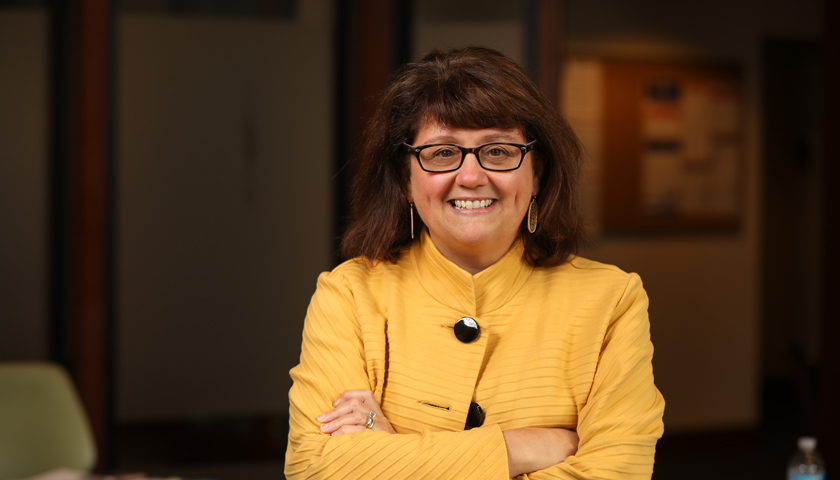Calm in the Time of Coronavirus

When it comes to being mindful, Psychology Professor Susan Orsillo wrote the book. In fact, she’s written several. Throughout her career she has specialized in the development, evaluation, and dissemination of acceptance- and mindfulness-based behavioral prevention programs and interventions; anxiety disorders; and student mental health.
Orsillo shared her expert advice on being mindful amid the unprecedented challenges posed by COVID-19.
Q: What exactly is mindfulness?
A: Mindfulness involves intentionally bringing our full attention to the present moment and observing whatever we notice, with curiosity and compassion. Although mindfulness is rooted in Buddhist traditions, we all have the capacity to use this practice.
Q: How can being mindful help people reduce or manage their anxiety in the time of COVID-19?
A: It is natural for us to feel anxious about COVID-19, given how quickly our routines have become disrupted. Many people are struggling with significant challenges: the illness of a friend or relative, financial struggles, balancing childcare with work, loneliness, and the disappointment of cancelled plans. Practicing mindfulness involves acknowledging that these stressors are real and painful, and being kind to ourselves.
Q: Can mindfulness help calm racing thoughts?
A: When we are anxious, our minds wander to the future. We think,“What if I get sick?” or “What if I can’t get a job after graduation? What if, what if, what if…?” If our mind keeps running through all these scenarios, we can get caught in an endless cycle of worry that feeds our anxiety, interferes with our sleep and concentration, and causes us to become irritable.
Practicing mindfulness can help us:
- notice when we are stuck in that worry cycle;
- recognize that worrying is something we all do from time to time when we struggle with uncertainty;
- and make the choice to intentionally bring our attention back to the present moment. Again, and again, and again.
Q: What are some examples that people can put into practice right away—even if they’re cooped up in small apartments or even dorm rooms?
A: People can practice mindfulness in lots of ways. There are formal practices online (see resources below). People can also practice more informally—just checking in with themselves from time to time to ask, “Where is my attention right now?” and gently guiding their attention back to the present.
Q: Great! So mindfulness can be achieved immediately?
A: Our attention is not going to stay where we set it. It’s very important that we have patience with ourselves when we notice we’re right back in our worries again. Our minds are like energetic puppies always sniffing around. And just like we shouldn’t punish puppies for being puppies, we shouldn’t punish our minds for their busy nature. Instead, we accept our minds for what they are and train them with patience and love.
Q: Can mindfulness help people combat COVID-19–related media overload?
A: Sometimes we end up reading Twitter feeds or watching the news more than we intended to, which can further feed our anxiety and worry.
Mindfully checking in and asking ourselves questions like these can be quite valuable:
- Am I learning new information right now that can help me to stay healthy and well, or am I caught in a cycle of sensational news?
- Is this a valuable use of my time in this moment, or is there something else I could be doing to increase my sense of well-being—like exercising, reading a book, or calling a friend?
Q: Do you have to be in great physical shape to be mindful or can everyone practice it?
A: Although yoga can be a helpful way to practice mindfulness—particularly since focusing on our body can anchor us to the present moment—it is by no means the only way. Media portrayals of calm-looking, young, white, fit women in gravity-defying yoga positions and designer workout clothing send the message that mindfulness is only relevant to a certain demographic.
But mindfulness is something that people of all ages, sizes, and abilities can practice in some way, regardless of their race, religious beliefs, gender identity, or sexual orientation. In fact, one of the most commonly used mindfulness practice involves bringing our attention to something we all do, all of the time—breathe!
Q: Can being mindful help strengthen our relationships with others—even while we’re social distancing to keep safe? If so, how?
A: People assume that we practice mindfulness to draw our attention away from something unpleasant—like worry. But the spirit of mindfulness involves drawing your attention toward something truly meaningful and precious—the present moment. Then we fully experience whatever it is: the scent of our favorite candle, the taste of a delicious food, or the sensation of our pet’s fur.
The greatest gift we can give is our full attention. We tend to multi-task: talking to a friend while watching Netflix, or listening to our partner talk about their day while thinking about what’s for dinner. Being mindful in our relationships means intentionally choosing to be fully present—even when other factors compete for our attention.
When we are physically distant from others, we need to be more intentional about reaching out and socializing by phone, text, or Zoom. One benefit to this is that we can connect in new, mindful ways. After all, it is the quality of our connections, not the quantity of likes we get on Twitter or the number of parties we attend, that contributes to our social support.
Q: Are there specific resources you’d point people to?
A: This website features some books I have co-written with colleagues on this topic, along with audio clips of mindfulness practices.
Mindful.org has a series of free live mindfulness webinars this month.
Headspace is an app you can try out for free.
Note: This interview has been edited for length.
Media Contact
Greg Gatlin
Office of Public Affairs
617-573-8428
[email protected]



